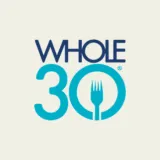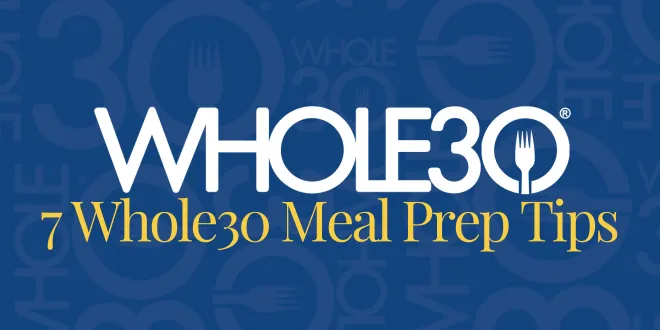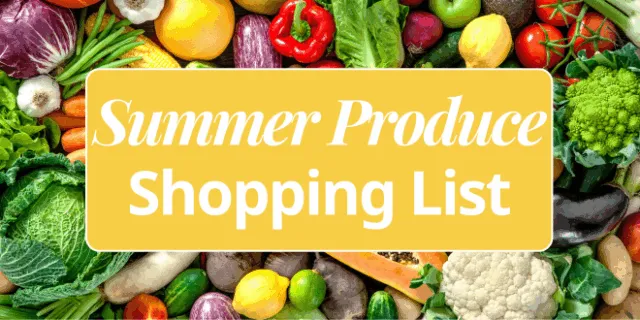For a seemingly harmless question, “What’s for dinner?” sure can pack a stressful punch—if you aren’t prepared with a ready-made answer. Add a Whole30 to the typical dynamics of the ‘what to eat’ conversation and you have a recipe for frustration. Having a plan and preparing—with the help of useful Whole30 meal prep tips—is your best bet to avoid any angst over what’s gracing the table for your next meal.
The advice below is set up to take you through the preparation process from start to finish. You can use it as a roadmap for easy Whole30 meal prep, and a template for success any time of the year. So, follow along on this guided tour of how to prep for a Whole30 full of delicious meals. And use it to permanently take the power out of the dreaded “What’s for dinner?” discussion.
Prep starts with planning
You’ve sharpened your knives. You washed up the cutting boards. Your wobbly stack of empty glass containers is ALMOST touching your kitchen ceiling.
Now what?
You go back to square one. Pull out the paper and pen (or, since it’s the 2020s, your Notes app). Luckily, developing your Whole30 meal plan is easily done. All you need is a few minutes of time and a bit of help.
Browse the hundreds of compatible and delicious Whole30 recipes and pick the ones that jump out at you. Even ask your partner or kids to help. That’s also a great way to make sure they’re looking forward to the week’s meals, as well.
Write down (physically or digitally, your choice) the meals you want to try this week. Leave room under each choice to list ingredients you’ll need and any other special considerations. This is a great place to note if you need your Instant Pot or slow cooker.
Then, you’ll decide which recipes will cover which meals. You can lay all of this out on a calendar or spreadsheet, too, if you want. It’s very helpful, but if it seems a bit extra and intimidating, just list it out. That way you can ensure you have coverage for the full week.
Make sure to maximize your use of multitaskers
As you’re finalizing your plan, look at ingredients or recipes that can fill more than one function and spot on your menu.
Being efficient will pay off big time. You’ll want to plan for leftovers (full meals or particular ingredients) to eat or use later. A great example of Whole30 menu multitasking is cooking extra protein with Monday’s dinner. It means you can then put it on a salad on Wednesday. Sauces, dressings, and roasted veggies are other great non-protein multitaskers for your meal plan.
Identifying which items can help cover multiple meals will help you maximize your efficiency, time, and stress in the kitchen. If you want to take this to the next level, focus your Whole30 meal prep efforts solely on multitasking foods that can fill out ingredient meals.
You can remix these combinations of ingredients over and over throughout the week. Think of all the different dishes you can make with roasted chicken thighs, sheet pan veggies, a batch of cauliflower rice, and a few easy sauces?
Forage in your pantry and shop smartly
Now that you know what you’ll be prepping and cooking, you can start acquiring the ingredients you need. The best place to start is a quick rummage through your pantry.
One of the best tips for preparing your house for a Whole30 is a pantry cleanout. If you haven’t undertaken the task, it’s a worthwhile endeavor. That way you can shop your pantry knowing you won’t have a tempting staredown with a bag of your favorite salty or sweet treats.
Once you feel comfortable with what you’ll encounter in your pantry, see what kind of staples you’re running low on, and what you definitely don’t need to buy more of. (Nobody likes to come home with a fresh jar of roasted red peppers just to find four waiting on the shelf.) Make a list of all the other ingredients you need from the store to execute your plan.
Whether you shop online (Hello, Thrive Market!) or in store, having a list will make your life a lot easier—and your final receipt a bit shorter. Buying only what you need is just part of your smart shopping strategy, though.
Look for deals to save money. But also think about paying up a bit for some pre-cut or pre-prepared veggies, proteins, or other ingredients. Your time and sanity is worth a lot, so spend the extra $1.50 for the pre-chopped peppers if deseeding and slicing will haunt your nightmares.
The Whole30 Approved logo is another time-saver when you’re in the store. If you know you need pasta sauce for your spaghetti squash, finding that logo will save you from reading ingredient list after ingredient list in search of hidden sugar.
Think like a chef and set up the proper mise en place for your best possible cooking sessions
So you’ve planned and shopped. Now it’s time to return to your Top-Chef-ready knives and impressive container tower. It’s time to peel, chop, slice, dice, and grate your way to culinary bliss.
This is the part where you’re doing the nuts and bolts of your Whole30 meal prep. If you’re doing the preparation—and following basic food safety recommendations—there’s really no wrong way to do this part.
Most people either work on readying ingredients one day and cooking on another or prepping and batch cooking on the same day. Do whatever works best for you. But either approach will be made easier by putting on your chef hat (bonus points if you actually have a toque to don) and make yourself a mise en place.
That’s just the fancy way to say you have your ingredients prepped, laid out, and ready to be cooked and put together for a delicious dish. You’ll have to have herbs washed, destemmed, and chopped. Any vegetables should be washed, peeled (if needed), and cut into whatever size and shape you need. Proteins are trimmed, portioned, and seasoned or marinated (if the recipe calls for it.)
Whether you’re stashing your prepped ingredients in the fridge or throwing them right into the fires, you want to be able to have what you need ready to go. Splitting these steps will allow you to focus on cooking. And you won’t feel stressed that the mushrooms need cleaned and sliced in time to go into your stir fry.
You’ll thank yourself for that organization when your final dish comes out tasting great without you even breaking a stress-induced sweat. Also, you’ll save yourself from doing a full load of dishes every night of the week. The dishwasher might get a workout on the weekend, but you’ll have less to worry about on Wednesday.
Feed your family and your freezer at the same time
If you’re going to cook, you might as well COOK. Leftovers are key to easy Whole30 meal prep. And cooking a bigger batch will help you cover a couple of meals with only a bit more effort on cook day.
Double your recipe to have a full meal left for lunch the next day or later in the week. Make extra protein for amazing salads or roasted veggies for a scramble on a subsequent morning or evening. Go all out on a big batch of pesto. You’ll never be sad to have extra green gold ready to drizzle on basically anything.
Your freezer is also one of your most important companions on this Whole30 culinary journey. Triple your recipes and freeze whatever you have left. That will give you a cushion for days where you really don’t want to do anything but work the microwave. Feeding your freezer is also a pretty great way to never be caught unprepared for the “What’s for dinner?” discussion again.
Learn for your successes and failures to make it easier to plan
Every week doesn’t have to be a fresh slate of brand-new recipes. Actually, it’s good to revisit favorites and lean on what has worked for you in the past. This is especially true during your Whole30. That kind of automation will make it easier to find success by eating compatible meals every day. There’s nothing wrong with feasting on your favorite roasted veggie scramble for breakfast every day—as long as food fatigue doesn’t set in.
Tracking the recipes that were hits will make it easier to know what you can easily drop into a week’s meal plan. When you’re struggling for what to list for Thursday, reach into your collection of favorites and pluck out a certified crowd-pleaser. It doesn’t have to be any harder than that.
Knowing what you like—and the recipes that have worked great for you—also makes it easier to improv if you need to. If you’re looking at a fridge full of ingredients (cooked or not) you don’t even need a recipe to throw together a meal you know will taste great. These can be based on an ingredient meal template or a crackle of culinary inspiration. Who knows? Maybe you’ll create the next great combination that takes over the food world.
Keeping track of your favorites makes life easier, and still leaves room for strokes of genius and creativity. So it’s worth the few minutes it takes to add that beef stew recipe to your list of go-to meals.
Find the Whole30 meal prep approach that works for you
Food is personal. Everybody has a unique set of flavors that appeal to them. Cooking techniques and methods vary widely. So it only makes sense that the way you meal plan and prep are just as singular.
Use the roadmap and tips above to help you find your best Whole30 meal prep approach. It should provide a good foundation to build on. But you won’t hurt anybody’s feelings if you take what you just read and make it your own. The important thing is that you save time, stress less, and have a surefire way to minimize the damage next time someone asks you: What’s for dinner?
















